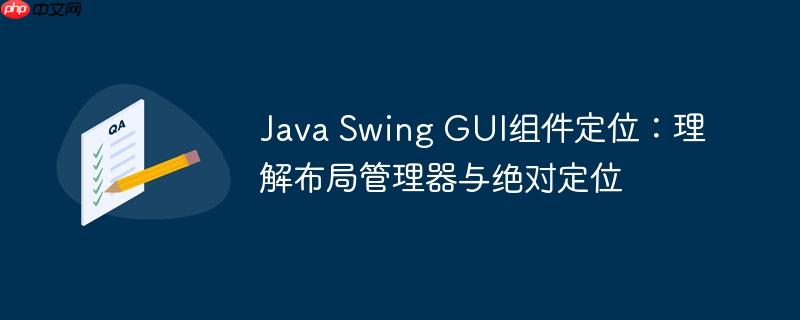
在java swing中,开发者经常会遇到尝试通过setlocation()或setbounds()方法来精确控制gui组件(如按钮、标签、文本框等)位置和大小,但发现这些设置似乎无效的问题。这通常不是因为方法本身有问题,而是因为对swing的布局管理机制缺乏深入理解。swing组件的最终位置和大小,很大程度上是由其父容器所使用的“布局管理器”(layout manager)决定的。
布局管理器是Swing中一个核心概念,它负责自动排列容器内的组件。当一个容器设置了布局管理器时,该管理器会根据其自身的规则来计算并设置所有子组件的位置和大小,这会覆盖掉你手动通过setLocation()或setBounds()进行的设置。
常见的布局管理器包括:
绝对定位(Null 布局)
如果你确实需要对每个组件进行像素级的精确控制,即完全禁用布局管理器的自动排列功能,你可以使用“绝对定位”,也称为“null 布局”。
立即学习“Java免费学习笔记(深入)”;
当GUI界面已经显示出来后,如果你通过代码动态地改变了某个组件的位置、大小、可见性或添加/移除了组件,这些改变可能不会立即在屏幕上反映出来。这是因为Swing需要被告知界面布局可能已失效,需要重新计算和绘制。
通常,在动态改变组件位置或大小后,你需要调用其父容器的revalidate()方法,然后可能还需要调用repaint()方法,以确保界面更新。
// 示例:动态改变按钮位置后更新界面
JButton myButton = new JButton("点击我移动");
// ... 初始化并添加到容器 ...
myButton.addActionListener(e -> {
// 改变按钮的位置和大小
myButton.setBounds(myButton.getX() + 10, myButton.getY() + 10, 120, 35);
// 通知父容器重新验证布局并重绘
myButton.getParent().revalidate();
myButton.getParent().repaint();
});为了避免常见的定位问题并构建健壮的Swing应用,请遵循以下最佳实践:
选择合适的容器:
设置背景图像:
// 示例:带有背景图像的JPanel
class BackgroundPanel extends JPanel {
private Image backgroundImage;
public BackgroundPanel(String imagePath) {
try {
backgroundImage = new ImageIcon(imagePath).getImage();
} catch (Exception e) {
e.printStackTrace();
}
}
@Override
protected void paintComponent(Graphics g) {
super.paintComponent(g); // 调用父类的paintComponent,确保背景色等被绘制
if (backgroundImage != null) {
// 绘制背景图像,覆盖整个面板
g.drawImage(backgroundImage, 0, 0, getWidth(), getHeight(), this);
}
}
}避免冗余的默认设置:
GUI应用结构:
以下代码示例展示了如何正确地使用null布局来定位组件,并包含了上述最佳实践:
import javax.swing.*;
import java.awt.*;
import java.awt.event.ActionEvent;
import java.awt.event.ActionListener;
public class ComponentPositioningTutorial extends JFrame implements ActionListener {
// 自定义JPanel用于背景图像
static class BackgroundPanel extends JPanel {
private Image backgroundImage;
public BackgroundPanel(String imagePath) {
try {
// 确保图片路径正确
backgroundImage = new ImageIcon(imagePath).getImage();
} catch (Exception e) {
System.err.println("无法加载背景图片: " + imagePath);
e.printStackTrace();
}
}
@Override
protected void paintComponent(Graphics g) {
super.paintComponent(g);
if (backgroundImage != null) {
// 绘制背景图像,覆盖整个面板区域
g.drawImage(backgroundImage, 0, 0, getWidth(), getHeight(), this);
}
}
}
public ComponentPositioningTutorial() {
setTitle("GUI组件定位示例");
setSize(800, 600);
setLocationRelativeTo(null); // 窗口居中显示
setDefaultCloseOperation(JFrame.EXIT_ON_CLOSE); // 关闭窗口时退出应用程序
// 1. 创建一个带有背景图像的JPanel作为内容面板
// 替换为你的实际图片路径,例如 "C:\path\to\your\image.jpg"
BackgroundPanel contentPanel = new BackgroundPanel("C:\...\background.jpg");
// 设置内容面板的布局为null,以允许绝对定位
contentPanel.setLayout(null);
// 2. 创建JButton并设置其位置和大小
JButton btnOk = new JButton("OK");
// 在null布局下,setLocation和setBounds方法将生效
btnOk.setBounds(50, 50, 100, 30); // x, y, width, height
btnOk.addActionListener(this);
contentPanel.add(btnOk); // 将按钮添加到BackgroundPanel
JButton btnAnother = new JButton("另一个按钮");
btnAnother.setBounds(200, 100, 150, 40);
contentPanel.add(btnAnother);
// 3. 将内容面板添加到JFrame
// JFrame的默认内容面板已经存在,直接添加即可
this.add(contentPanel);
setVisible(true);
}
@Override
public void actionPerformed(ActionEvent e) {
if (e.getActionCommand().equals("OK")) {
JButton sourceButton = (JButton) e.getSource();
// 动态改变按钮位置和大小
sourceButton.setBounds(sourceButton.getX() + 10, sourceButton.getY() + 10, 120, 35);
// 动态改变组件位置后,需要调用revalidate()和repaint()
// revalidate父容器,使其重新计算布局
sourceButton.getParent().revalidate();
// repaint父容器,使其重新绘制
sourceButton.getParent().repaint();
System.out.println("OK按钮被点击,位置已更新!");
}
}
public static void main(String[] args) {
// 在事件调度线程(Event Dispatch Thread, EDT)中创建和运行GUI,这是Swing的最佳实践
SwingUtilities.invokeLater(ComponentPositioningTutorial::new);
}
}理解Java Swing中的布局管理器是有效定位GUI组件的关键。当setLocation()和setBounds()方法看似无效时,通常是由于父容器的布局管理器在接管组件的尺寸和位置。你可以选择:
此外,在组件位置或大小动态变化后,务必调用revalidate()和repaint()来确保界面及时更新。遵循将组件添加到适当的容器(如JPanel)以及正确处理背景图像等最佳实践,将有助于构建更稳定和可维护的Swing应用程序。
以上就是Java Swing GUI组件定位:理解布局管理器与绝对定位的详细内容,更多请关注php中文网其它相关文章!

Windows激活工具是正版认证的激活工具,永久激活,一键解决windows许可证即将过期。可激活win7系统、win8.1系统、win10系统、win11系统。下载后先看完视频激活教程,再进行操作,100%激活成功。

Copyright 2014-2025 https://www.php.cn/ All Rights Reserved | php.cn | 湘ICP备2023035733号